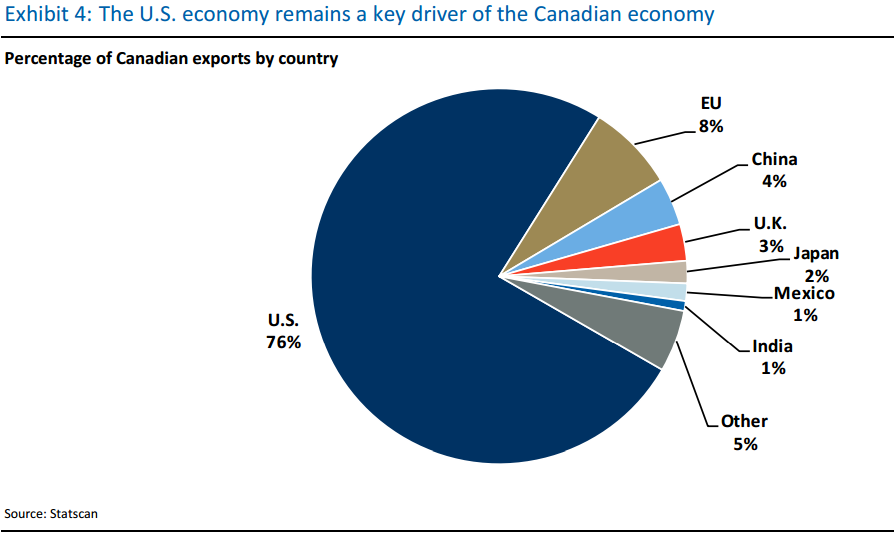China's Economy: Exposed By Reliance On Exports And Tariffs

Table of Contents
The Export-Oriented Engine: A Double-Edged Sword
China's economic growth has been inextricably linked to its ability to manufacture and export goods at a global scale. This export-oriented model, while incredibly successful, presents a double-edged sword, creating significant dependencies and vulnerabilities.
Over-reliance on Global Demand
- China's GDP growth is heavily influenced by global demand for its manufactured goods. A significant portion of its GDP is directly tied to export performance.
- Exports are concentrated in specific sectors, including electronics, textiles, and machinery, making the economy susceptible to shocks in these particular markets. A downturn in global demand for electronics, for instance, can significantly impact China's overall economic growth.
- Fluctuations in global demand, coupled with potential recessions in major importing countries like the US and EU, pose significant risks to China's economic stability. Any slowdown in these economies can directly translate into reduced export orders and slower GDP growth for China.
- The reliance on foreign markets creates a vulnerability to external factors beyond China's control, highlighting the need for diversification.
Vulnerability to Geopolitical Shifts
- Trade wars and geopolitical tensions, such as the US-China trade war, directly impact Chinese exports. Imposed tariffs and trade restrictions disrupt supply chains and reduce export volume, leading to economic slowdown.
- Retaliatory tariffs imposed by trading partners can significantly harm specific industries. For example, tariffs on Chinese agricultural products or technology goods can lead to job losses and reduced economic activity within those sectors.
- Geopolitical instability in any major trading partner can disrupt supply chains and create uncertainty, impacting investment decisions and overall economic confidence.
The Tariff Tightrope: Navigating Trade Disputes
The imposition of tariffs presents significant challenges to China's economy. Navigating these trade disputes requires strategic responses and long-term planning.
Impact of Tariffs on Chinese Industries
- Tariffs imposed by other countries have demonstrably affected various Chinese industries. The technology sector, in particular, has faced substantial challenges due to trade disputes and import tariffs.
- The agricultural sector has also felt the impact, with tariffs leading to decreased exports and impacting farmers' livelihoods. Reduced export volumes translate to lower revenues and potential job losses within these sectors.
- The ripple effect of tariffs extends beyond the directly targeted industries, impacting related sectors and potentially slowing overall economic growth.
China's Response Mechanisms
- To mitigate the negative impacts of tariffs, China has pursued several strategies, including diversifying its export markets, focusing on boosting domestic consumption, and investing heavily in technological innovation.
- Diversifying export markets helps to reduce reliance on any single trading partner, mitigating the risk associated with trade disputes. This involves seeking new markets in Africa, Latin America, and other regions.
- Stimulating domestic consumption is crucial for reducing export dependence. Government initiatives aimed at increasing disposable income and promoting domestic brands are key to this strategy.
- Technological innovation is vital for upgrading the Chinese economy, transitioning from low-value-added manufacturing to higher-value, more technologically advanced sectors.
The Path to Diversification: Reducing Export Dependency
To ensure long-term economic stability and resilience, China needs to actively pursue diversification strategies. This involves a shift towards a more balanced economy, less reliant on exports.
Promoting Domestic Consumption
- Increasing domestic consumption is paramount to reducing reliance on exports. A stronger domestic market reduces the vulnerability to external economic shocks.
- Challenges include increasing disposable incomes for a large segment of the population, fostering greater consumer confidence, and encouraging spending on domestically produced goods and services.
- Government initiatives such as tax cuts, social welfare programs, and infrastructure development can all contribute to stimulating domestic demand.
Investing in Innovation and High-Tech Sectors
- Investing in technological innovation and high-tech industries is essential for building a more resilient and sustainable economy. This reduces dependence on low-value-added manufacturing exports.
- Government policies focused on supporting research and development, attracting foreign investment in high-tech sectors, and fostering entrepreneurship are crucial to this transformation.
- Transitioning towards a more knowledge-based economy will not only improve productivity and competitiveness but also reduce vulnerability to external trade shocks.
Conclusion
China's remarkable economic growth has been significantly driven by its export-oriented model. However, this dependence on global demand and susceptibility to trade disputes, particularly those involving tariffs, exposes vulnerabilities. The strategies discussed—diversifying export markets, boosting domestic consumption, and investing in innovation—are critical steps towards building a more resilient and sustainable economy. Understanding China's economic vulnerabilities related to its export dependence and tariff exposure is crucial for investors, policymakers, and businesses alike. Further research into China's evolving economic strategies and the global implications of its trade relationships is essential to navigate the complexities of China's economy and its future trajectory. Continue learning about the impact of exports and tariffs on China's economy to stay informed about this crucial aspect of the global economic landscape.

Featured Posts
-
 Ukraine Faces Renewed Russian Aerial Offensive Us Peace Initiative In Play
Apr 22, 2025
Ukraine Faces Renewed Russian Aerial Offensive Us Peace Initiative In Play
Apr 22, 2025 -
 White House Cocaine Found Secret Service Concludes Investigation
Apr 22, 2025
White House Cocaine Found Secret Service Concludes Investigation
Apr 22, 2025 -
 Five Key Economic Points From The English Language Leaders Debate
Apr 22, 2025
Five Key Economic Points From The English Language Leaders Debate
Apr 22, 2025 -
 San Franciscos Anchor Brewing To Shut Down After 127 Years Of History
Apr 22, 2025
San Franciscos Anchor Brewing To Shut Down After 127 Years Of History
Apr 22, 2025 -
 Hegseth Under Fire New Signal Chat And Pentagon Chaos Claims
Apr 22, 2025
Hegseth Under Fire New Signal Chat And Pentagon Chaos Claims
Apr 22, 2025
